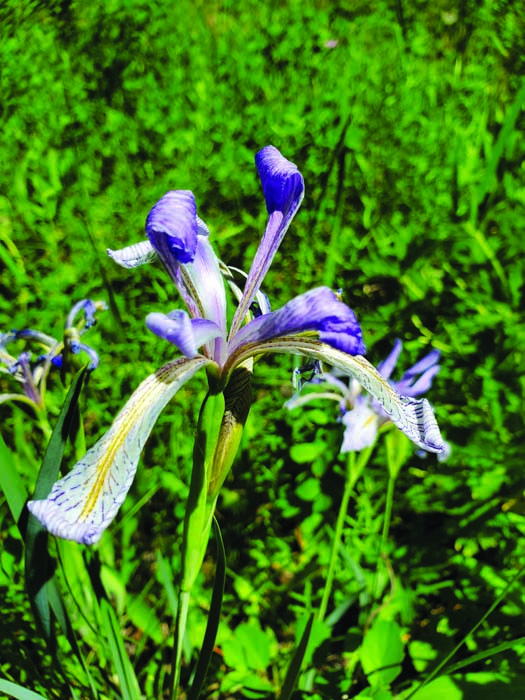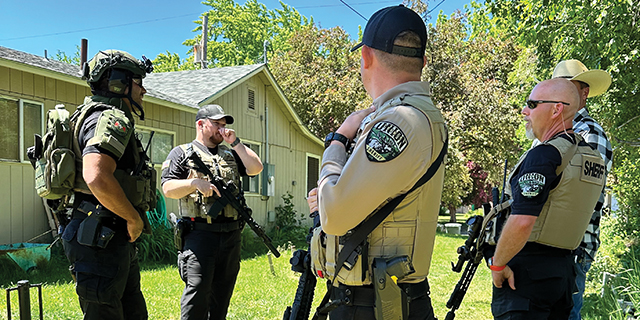Out and About: Greeting summer on the wildflower trail
Published 7:45 am Wednesday, June 12, 2024

- A wild iris blooms along the Phillips Shoreline trail on June 11, 2024.
I greeted summer as I would an old friend who I had not seen for many months.
With a smile.
Also I took a lot of photographs.
Summer is not my favorite season — I prefer the crisp, clear days of autumn — but it is unique in one sense.
For me, summer arrives multiple times each year, and I enjoy each meeting.
That the season’s beginning is not a singular event has to do with the dramatic differences in topography in Northeast Oregon.
In a region where the elevation ranges from below 1,000 feet in the Columbia Basin to nearly 10,000 along the roofs of the Wallowas, summer’s arrival extends over a period about as long as the season itself.
Some years I recognize summer as early as April, on a day in, say, Hells Canyon when the sunshine ascends from mere warmth to outright heat.
In my yard in Baker City, elevation about 3,440 feet, this milestone more often happens in May. One day, while tussling with the infernal weeds or pruning limbs from the English yew that each year creeps a bit closer to the east side of the house, I will detect real summer in a breeze that is slightly less than refreshing.
As the days and weeks pass, I chase summer into the mountains.
In the foothills the season typically begins, by my unscientific reckoning, in June.
Finally, probably in July but occasionally not until August, I encounter summer among the high peaks, where grainy snowdrifts share alpine tundra with budding wildflowers.
I relish the reliability of this annual sequence.
I like to putter about in my yard on a hot afternoon and need only glance to the west at the Elkhorns, or look northeast toward the Wallowas, to see slopes still deep in snow, places where summer has yet to emerge.
On the afternoon of June 11 I needed photos of two places near Baker City, one along Old Auburn Road about a dozen miles southwest of town, the other at Phillips Reservoir several miles farther in that direction.
I went for a short hike on the trail along the south side of the reservoir, and as I followed the meandering dirt path between ponderosa pines and the occasional juniper or Douglas-fir, I encountered summer.
The season revealed itself sensuously — in the fresh green of pinegrass, the sharp scent of sun-warmed ponderosa bark, the soft cushion of pine needles, still damp from recent rain, beneath my boots.
But for me the surest sign of summer, the genuine article rather than the ersatz and untrustworthy version that tries to fool a person during an early heat wave, is the riot of wildflowers.
As with most such natural displays, it is brief.
Particularly so, it seems to me, at the reservoir’s modest elevation of about 4,100 feet.
I generally migrate, in the manner of deer and elk, to loftier places before the end of June. By July the land around the reservoir becomes sort of prickly as the grasses cure and the flower blooms desiccate and the pine needles crunch underfoot and the pleasing green of early summer gives way to dull tans and grays.
But certain days, including my hike on June 11, seem to be the apotheosis of summer, as close to perfect as anyone can reasonably expect from any place.
It is a precious period, when the longer-lasting flowers such as purple lupine and pink sticky geranium and vivid yellow heartleaf arnica share patches of forest with the more ephemeral blossoms that thrive only while the soil is still moist from rain and residual snow.
As I walked I noticed two such species — the rich pink-purple of wild onion and the delicate purple of wild iris.
I jotted more than a dozen species on my notepad, and there were several others whose names I could not recall (or, perhaps more likely, have never learned).
All seemed to be at or near the peak of their annual palette-spanning show — purple penstemon and wild hyacinth, pink wild rose, the unique red and yellow of columbine, white yarrow and buckwheat, the unique shade, neither orange nor red, of paintbrush, and a feast of yellows, cinquefoil and arrowleaf balsamroot and Oregon sunshine.
The colors beside the trail competed for my attention with other sights.
The reservoir, which for the second straight year has risen to nearly three-quarters of its capacity, is a much more scenic foreground than it was during the drought years of 2020-22, when the expanses of bare dirt between the forest and the water reminded me of a particularly ugly, and large, stain around the rim of a bathtub.
But the grandest scenery, as is always the case here except on a stormy day, is supplied by the Elkhorns.
The mountains crowd the whole of the northern horizon.
Although the warm weather that dominated the first third of June stripped most of the snow from this side of the Elkhorns, the peaks, including 9,106-foot Rock Creek Butte, highest in the range, are still speckled with splotches of white.
Up there, among the mountain goats, summer might hold off for another couple weeks.
But down in the valley, where the flowers are in bloom and the aroma of pine is heavy, there can be no question about which season reigns.
If You Go
Trails run along both the south and north shores of Phillips Reservoir, about 17 miles southwest of Baker City. The trails total about 12 miles. To circumnavigate the reservoir requires a short stint on Hudspeth Lane and Highway 7 at the west end, and crossing Mason Dam, via a gravel road, on the east.
The trail on the south shore starts beside Black Mountain Road at the south end of the dam. Black Mountain Road branches off Highway 7 near the dam.
The south trail can also be accessed from Southwest Shore and Millers Lane campgrounds.
Access points for the north trail include the Mason Dam boat ramp, Union Creek Campground, Social Security Point and Mowich Loop picnic area, all off Highway 7.




